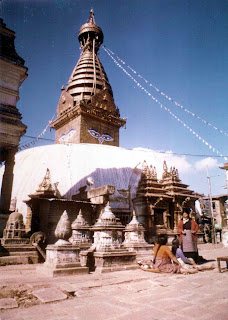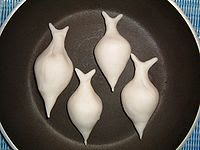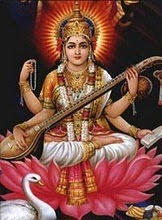 Maghe Sangranti
Maghe Sangranti is starting festival of the month
Magh.It lies in the middle of January month.This festival bring prediction month of
Poush month , it is middle of December month. This
Magh month is coldest day of the year , it indicate the coming warmer and good days of health and fortune. In this day, great significant of the holy bathing ceremony is performed in the sacred river, stream as well as at
Sankhamul.
Sankhamul is located banks of holy
Bagmati river,at
Patan.
Sankhamul is famous for holy bath and most sacred sites for this purpose , nowadays it has been a decline in the fulfillment of this ritual, due to water pollution in the river site. Recently people go in the small house of dawn just to sprinkle themselves with the water. They pay homage to varies duties specially the temple of Red
Machhindranath and
Agimata.In this festival holy bathing and worship of shrines,special kinds of foods just like till
laddoos ( sesame seeds ball cake ),
chaku ( molasses ),ghee ( pure butter ),sweet potato,
Khichadi ( mixture of rice and black lentils ) and green spinach are taken on this day. A family come together and shares these with pleasureful.Married daughter and families are invited to parental house for celebrating this festival and blessing. In
Newari communities put the mustard oil by lady head of house known as Mule on the head to all family members including daughter and blessing for good health. In
Newari communities also take holy bathing in the river. The Mule serve ghee,
chaku,Beaten rice, fry garlic,
tarul,
laddoos of sesame seeds to the family members and married daughters for blessing good health in the lifetime. This ceremony is very important in
Newari communities.
Maghe Sangranti has its own legend.It command to return that once a merchant from the town of
Bhadgaon despite of his thriving business noticed that his supply of sesame seeds
hadn't diminished .When looking into the matter he found an idol of the Lord Vishnu hidden deep beneath the seeds. Since then on this day the Til
Madhav Narayan idol is worship with the belief that God will continue to be generous in the supply of food and wealth of the
Bhadgoan community,Til
Madhav Narayan is located at
Bhaktapur,
Taumadhi. tole.In this place holy
puja of
Dipankar Buddha is performed. Whenever women don't have children,
prashad of ghee eaten by woman, according to ancient belief that she has children. In this festival
Daan is also performed to Brahmans,
Daan is that which people give some food and money etc to the Brahmans. This is good for the people, by this performed people get
Punye known as good for lifetime.


















